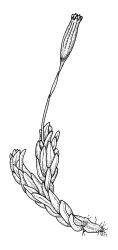- = Zygodon sect. Obtusifolii Malta, Latv. Univ. Raksti 6: 282 (1923)
- = Bryomaltaea Goffinet in Goffinet & Vitt, Bryol. Twenty-first Cent., 151 (1998)
Leratia is a small genus with a New Caledonian type, considered by Goffinet et al. (2004) to encompass three geographically disparate species. Because no material of the New Caledonian type has been available for study, no attempt is made to supply a description of the genus here. Brotherus (1925, p. 27–28) provided a detailed description and illustration of the type species (cited as Leratiella neocaledonica). A description of only the single N.Z. species is given here.
A commentary on Leratia is provided by Goffinet & Vitt (1998, p. 151), who at that time considered it to be monotypic, but who also noted many similarities to what they then termed Bryomaltaea obtusifolia (Hook.) Goffinet. Bryomaltaea is here considered a heterotypic synonym. Although Leratia neocaledonica is the type of the genus Leratia, the genus Bryomaltaea is typified by Zygodon obtusifolius Hook., which is founded on a Nepalese collection by Gardner, and not a N.Z. collection by Knight, as suggested by Goffinet.
The lamina-like cells on the abaxial surface of the costae and the lack of differentiated basal cells are significant defining features of Leratia. Goffinet et al. (2004), using data from four gene loci, convincingly demonstrated that the New Caledonian type, the Asian and Australasian L. obtusifolia, and the predominantly North American L. exigua (Sull.) Goffinet [Orthotrichum exiguum Sull.] belong to an isolated and strongly supported clade, to which they applied the generic name Leratia. Their taxonomic and nomenclatural conclusions are followed here, representing a departure from the treatment of Zygodon presented by Lewinsky (1990).
| Category | Number |
|---|---|
| Indigenous (Non-endemic) | 1 |
| Total | 1 |




